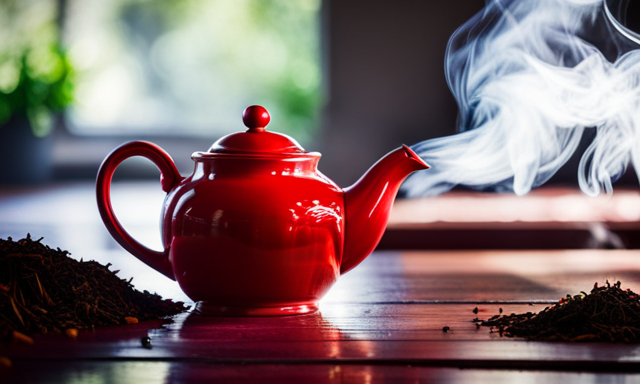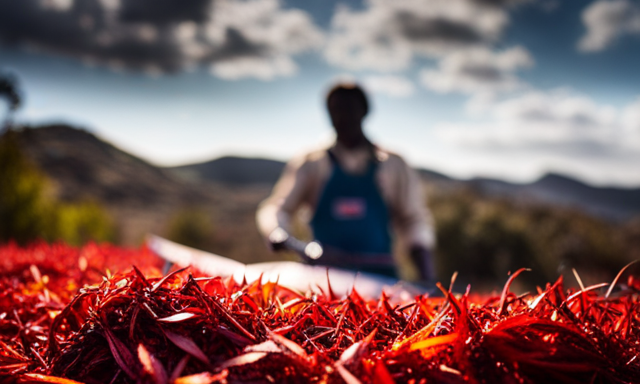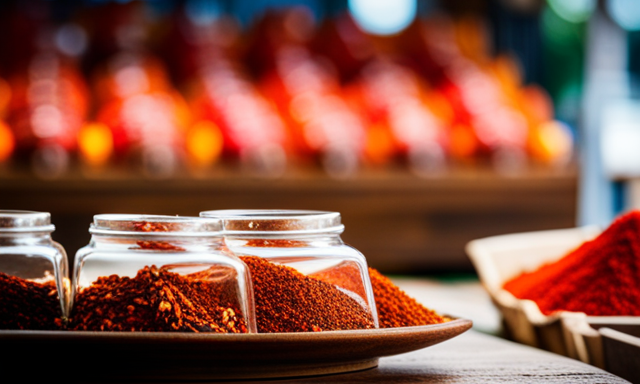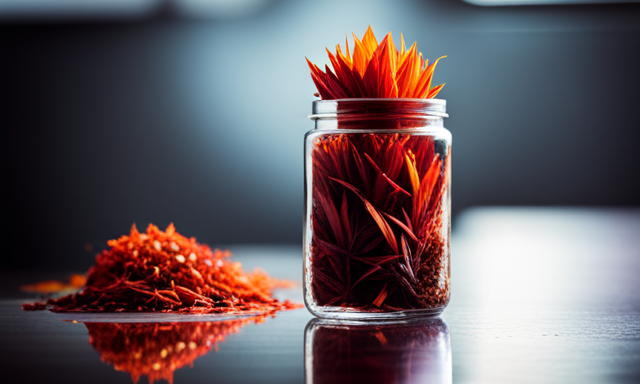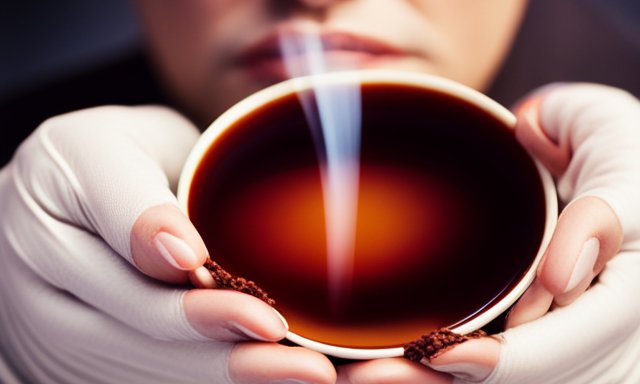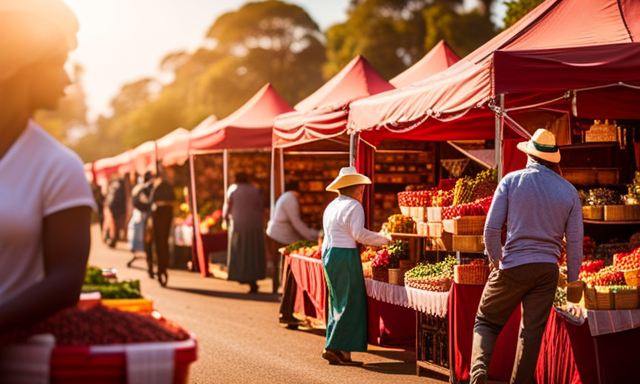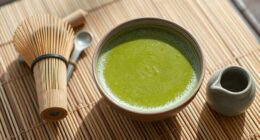I’ve always been fascinated by the art of brewing tea. There’s something magical about the way different flavors and aromas come together to create a comforting and soothing beverage.
One tea that has captured my attention recently is rooibos tea. Known for its rich, earthy flavor and numerous health benefits, rooibos tea has become a staple in my daily routine. But one question that always crosses my mind is: how long should I actually brew rooibos tea to get the perfect cup?
In this article, I will delve into the science behind brewing rooibos tea and provide you with all the information you need to achieve the ideal steeping time. From understanding the flavor profile to choosing the right leaves and enhancing the taste with additions, we’ll explore every aspect of brewing this delightful beverage.
So grab a cup of tea and let’s dive into the world of rooibos!
Key Takeaways
- Traditional steeping takes 5-7 minutes
- Cold brew requires refrigeration overnight
- Quick steeping lasts 2-3 minutes
- Double steeping increases time by a minute each steep.
Understanding the Flavor Profile of Rooibos Tea
Now, let’s dive into the wonderful world of rooibos tea and get to know its unique flavor profile a little better! Understanding the origins and exploring different rooibos tea varieties is key to appreciating its distinct taste and aroma.
Rooibos tea, also known as red bush tea, originates from the Western Cape province of South Africa, where it’s been consumed for centuries. It’s made from the leaves of the Aspalathus linearis plant, which is naturally caffeine-free and rich in antioxidants.
Rooibos tea has a naturally sweet and nutty flavor, often described as earthy and slightly fruity. The taste can vary depending on the specific variety and the processing methods used.
With this understanding, we can now transition into exploring the health benefits of rooibos tea.
The Health Benefits of Rooibos Tea
Furthermore, what are the health benefits of this popular African herbal infusion?
Rooibos tea, also known as red bush tea, is not only delicious but also packed with a plethora of health benefits. Research has shown that rooibos tea is rich in antioxidants, which can help protect the body against oxidative stress and reduce the risk of chronic diseases such as heart disease and cancer.
It is also known to have anti-inflammatory properties, which can help alleviate symptoms of conditions like arthritis and allergies. Additionally, rooibos tea is caffeine-free, making it a great alternative for those looking to reduce their caffeine intake.
It has also been found to support healthy digestion and promote better sleep. With its numerous health benefits, choosing the right rooibos tea leaves is essential to fully enjoy its goodness.
Choosing the Right Rooibos Tea Leaves
When selecting the perfect leaves for your cup, picture yourself savoring the rich flavors and vibrant aromas of a carefully chosen infusion. To ensure the best quality, it’s important to choose the right rooibos tea brand. Look for brands that source their leaves from reputable farms and prioritize organic cultivation methods.
Additionally, consider the type of rooibos tea you prefer – green or red. Each variety offers a unique taste profile and health benefits.
Next, investing in good rooibos tea brewing equipment is essential for a satisfying tea experience. Opt for a teapot with a built-in infuser or a fine mesh strainer to prevent any loose leaves from entering your cup.
Finally, prepare your water for brewing by using filtered or spring water to enhance the natural flavors of the tea leaves. Transitioning into the subsequent section about preparing your water for brewing, this step ensures a perfect cup of rooibos tea.
Preparing Your Water for Brewing
To create a truly harmonious infusion, let your water dance with purity and grace before embracing the leaves. When preparing your water for brewing rooibos tea, it’s important to consider water filtration and boiling techniques.
Start by using filtered water to remove any impurities that could affect the taste of your tea. This ensures a clean and crisp flavor profile. When boiling the water, bring it to a rolling boil and then let it cool for a minute or two. This helps to release any excess oxygen and bring out the natural flavors of the tea leaves.
Once the water is ready, gently pour it over the rooibos tea leaves and allow them to steep. This will provide the perfect foundation for the subsequent section about heating the water to the proper temperature.
Heating the Water to the Proper Temperature
Achieve tea nirvana by ensuring your water is heated to the perfect temperature, allowing the flavors to mingle and entice your taste buds.
To achieve the ideal water temperature for brewing rooibos tea, you can employ various heating techniques. One method is to use a kettle with temperature control, allowing you to set it to the specific temperature recommended for rooibos tea, which is around 212°F (100°C).
Another option is to bring the water to a boil and then let it cool for a few minutes before pouring it over the tea leaves. This technique ensures the water is hot enough to extract the flavors without scalding the delicate leaves.
Lastly, if you don’t have any temperature control options, you can simply bring the water to a rolling boil and then let it sit for about a minute before adding the tea leaves. This will give you a slightly lower water temperature, perfect for rooibos tea.
Now that your water is at the perfect temperature, let’s move on to measuring the correct amount of tea leaves.
Measuring the Correct Amount of Tea Leaves
After heating the water to the proper temperature, the next step in brewing a perfect cup of rooibos tea is measuring the correct amount of tea leaves. This step is crucial for achieving the desired flavor and strength of the tea. Measuring accuracy plays a significant role in the brewing process, as too little tea can result in a weak and flavorless brew, while too much can make it overpowering and bitter. Additionally, the quality of the tea leaves also affects the final result. Opting for high-quality, loose-leaf rooibos tea will ensure a rich and flavorful cup. To help you visualize this step, imagine a 3-column and 5-row table, with each column representing the tea leaf quantity, brewing time, and resulting flavor strength. Now, let’s explore the next vital element in brewing rooibos tea – the steeping time.
Steeping Time for Rooibos Tea
Get ready to dive into the world of flavor as you let your cup of rooibos tea steep to perfection. When it comes to steeping rooibos tea, the optimal infusion time is around 5 to 7 minutes. This allows the leaves to release their full flavor and aroma, creating a delightful cup of tea.
However, it’s important to note that steeping duration can vary depending on personal preference. If you prefer a stronger brew, you can steep it for a few minutes longer. On the other hand, if you prefer a milder flavor, you can steep it for a shorter time.
Experimenting with different steeping times can help you find the perfect balance for your taste buds.
Now that your tea is steeped to perfection, let’s move on to enhancing the flavor with additions.
Enhancing the Flavor with Additions
To truly elevate your cup of rooibos tea, why not explore the world of flavor by adding a touch of sweetness or a splash of milk? Here are three ways to enhance the aroma and create unique flavor combinations:
-
Honey and Lemon: Add a dollop of honey and a squeeze of fresh lemon juice to your rooibos tea. The sweetness of honey perfectly complements the earthy notes of rooibos, while the citrusy kick of lemon adds a refreshing twist.
-
Vanilla and Almond Milk: Infuse your rooibos tea with the rich and creamy flavors of vanilla and almond milk. Simply add a splash of almond milk and a drop of vanilla extract to your brewed tea for a luscious and indulgent treat.
-
Ginger and Orange Zest: For a zesty and invigorating cup of rooibos tea, grate some fresh ginger and sprinkle orange zest into your brew. The spicy warmth of ginger pairs beautifully with the citrusy zest, creating a delightful flavor combination.
Now that you’ve enhanced the flavor of your rooibos tea, let’s move on to straining and serving your delicious creation.
Straining and Serving Your Rooibos Tea
Once you’ve infused your cup with delightful flavors, it’s time to strain and serve your aromatic rooibos tea creation. Straining techniques are crucial to ensure a smooth and enjoyable tea experience. To achieve this, you can use a fine-mesh strainer or a tea infuser to remove any loose tea leaves or additions you may have used during the brewing process. This will prevent any unwanted residue from ending up in your cup.
When it comes to serving suggestions, rooibos tea is versatile and can be enjoyed both hot and cold. For a hot cup, you can simply pour the strained tea into your favorite mug and savor its rich flavors. If you prefer it iced, let the tea cool down and then pour it over ice, adding a slice of lemon or a sprig of mint for an extra refreshing touch.
Now that you’ve mastered the art of straining and serving, it’s time to delve into the exciting world of experimenting with different brewing techniques, where you can further enhance the taste and aroma of your rooibos tea creation.
Experimenting with Different Brewing Techniques
Discovering new brewing techniques allows me to unlock a world of tantalizing flavors and captivating aromas, transforming my cup of rooibos tea into an extraordinary sensory experience.
When experimenting with different brewing methods, it’s important to note that the steeping time can greatly impact the taste and strength of the tea. Here are four brewing techniques to try and compare steeping times:
-
Traditional Steeping: Steep the rooibos tea in hot water for 5-7 minutes to extract the full flavor and aroma.
-
Cold Brew: Place rooibos tea leaves in cold water and refrigerate overnight for a smooth and mellow flavor.
-
Quick Steep: Steep the tea for 2-3 minutes for a lighter taste, perfect for those who prefer a mild brew.
-
Double Steep: Steep the tea twice, increasing the steeping time by a minute each time, to extract more flavor and depth.
By experimenting with these different methods and comparing steeping times, you can find your perfect cup of rooibos tea.
Frequently Asked Questions
Can I reuse the rooibos tea leaves for a second brew?
Yes, you can reuse Rooibos tea leaves for a second brew. Reusing the leaves not only helps save money but also allows you to enjoy the health benefits of Rooibos tea multiple times.
How does the flavor of rooibos tea compare to other types of tea?
Rooibos tea offers a unique flavor that sets it apart from other teas. Compared to green tea, it has a naturally sweet taste with hints of nuttiness. Plus, it’s packed with antioxidants and promotes relaxation and digestion.
Can I drink rooibos tea if I have a caffeine sensitivity?
Yes, you can drink rooibos tea if you have a caffeine sensitivity. Rooibos tea is naturally caffeine-free, making it a great alternative for those who are sensitive to caffeine. Additionally, it offers various health benefits such as antioxidants and anti-inflammatory properties.
Are there any side effects or potential risks associated with drinking rooibos tea?
There are no known side effects or risks associated with drinking rooibos tea. It is caffeine-free and rich in antioxidants, offering potential health benefits. The recommended daily intake is 2-3 cups.
Can I drink rooibos tea if I am pregnant or breastfeeding?
Yes, you can drink rooibos tea if you are pregnant or breastfeeding. It is a caffeine-free herbal tea that is safe and can offer various health benefits during this time.
Conclusion
In conclusion, brewing rooibos tea is a simple yet delightful process that allows you to savor the unique flavors and reap the numerous health benefits it offers.
One interesting statistic to note is that rooibos tea contains zero calories, making it a guilt-free beverage choice for those watching their calorie intake.
By following the steps outlined in this article, you can create a perfect cup of rooibos tea every time, customized to your taste preferences.
So go ahead, indulge in the soothing and delicious experience of brewing rooibos tea. Cheers!

